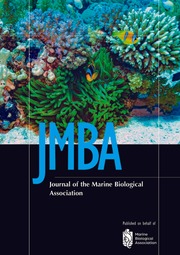Article contents
A cubical photometer for studying the angular distribution of submarine daylight
Published online by Cambridge University Press: 11 May 2009
Extract
Preliminary observations have been made in the English Channel off Plymouth on the average obliquity of illumination under water, and on the relative intensity of light reflected upwards at various depths, the readings being made with a cubical photometer containing six “Electrocell” selenium rectifier cells mounted behind opal glasses and Jena VG 9 (green) filters. The cells measured the light of wave-lengths about 480–580 mμ falling on upward-and on downward-turned horizontal surfaces, and on four vertical surfaces i n rectangular azimuths.
The average angle with the vertical or of obliquity was from 36 to 40°, and no significant difference could be detected between that for smooth sea and overcast sky, and that for rough sea and either high or low sun. Figures for smooth sea and sunlight are more difficult to obtain, as in the absence of drift due to wind the photometer may rotate.
No decrease in average obliquity with depth was found, in some cases there was evidence of a slight increase. This is in accordance with our previous results, and accords well with the constancy of extinction coefficient so often found throughout a series. It is not, however, in agreement with the careful work of Johnson & Liljequist, so further determinations would seem to be desirable.
The percentage of the light which was scattered back so as to fall on a downward-turned surface varied from 5.5 for comparatively opaque water (extinction coefficient 0.20) inside Plymouth breakwater, to 2.1 for very clear water (extinction coefficient 0.076) some miles off at sea. The presence or absence of sunlight had little effect, values close to 3.0 being obtained with and without sun for water having a coefficient close to 0.110.
Information
- Type
- Research Article
- Information
- Journal of the Marine Biological Association of the United Kingdom , Volume 24 , Issue 1 , January 1940 , pp. 271 - 281
- Copyright
- Copyright © Marine Biological Association of the United Kingdom 1940
References
REFERENCES
- 19
- Cited by

